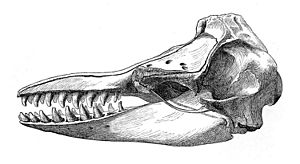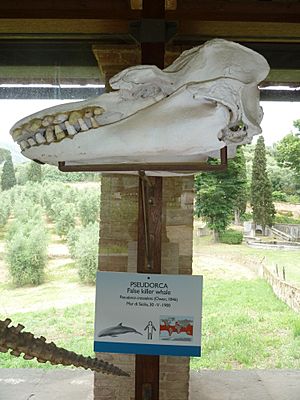False killer whale facts for kids
Quick facts for kids False killer whaleTemporal range: Middle Pleistocene–Recent
|
|
|---|---|
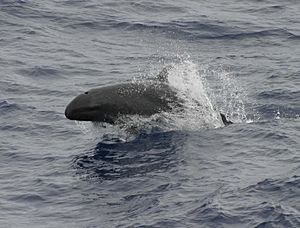 |
|
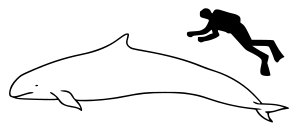 |
|
| Size compared to an average human | |
| Conservation status | |
| Scientific classification | |
| Genus: |
Pseudorca
|
| Species: |
crassidens
|
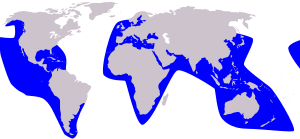 |
|
| Range of the false killer whale | |
| Synonyms | |
False killer whales (Pseudorca crassidens) are amazing dolphins. They are actually large members of the oceanic dolphin family. This species is the only one in its special group, called the Pseudorca genus.
These whales live in warm and mild waters all over the world. Their name might make you think they are like the famous Orcas. They do look a bit similar. Also, like orcas, false killer whales hunt and eat other dolphins and whales. But even with these similarities, they are not closely related.
Scientists have not studied false killer whales much in the wild. Most of what we know comes from examining whales that have gotten stranded on beaches.
Contents
Where False Killer Whales Live
False killer whales are found in many places, but their numbers are usually small. They prefer the open ocean in warm and mild areas. Sometimes, they are seen in cooler waters, but these are likely whales that have strayed from their usual homes.
They have been spotted in places like:
- The Mediterranean Sea and Red Sea
- The Atlantic Ocean, from Scotland to Argentina
- The Indian Ocean, near coasts and around the Lakshadweep Islands
- The Pacific Ocean, from the Sea of Japan to New Zealand
- Around Hawaii
Recently, a group of false killer whales was even seen hunting small sharks in Australia.
Hawaii's Whale Populations
The false killer whales near Hawaii are the most studied groups. There are three different groups around the islands:
- An offshore group, living further out at sea.
- A group near the northwestern Hawaiian Islands.
- A small group living around the main Hawaiian Islands. This last group is special and genetically different from the others.
Wholphins: A Unique Hybrid
Did you know that a false killer whale and a bottlenose dolphin once had a baby together in captivity? This amazing hybrid offspring was called a "wholphin"!
What False Killer Whales Look Like

False killer whales are mostly black. They have a grey area on their throat and neck. Their bodies are sleek and slender. They have a long, pointed head with 44 teeth.
Their dorsal fin (the fin on their back) is shaped like a sickle. Their flippers (side fins) are narrow, short, and pointed. On average, these whales are about 4.9 meters (16 feet) long.
- Female false killer whales can grow up to 5.1 meters (16.7 feet) long and weigh around 1,200 kilograms (2,600 pounds).
- The largest males can reach 6.1 meters (20 feet) long and weigh as much as 2,200 kilograms (4,900 pounds)!
How Humans Interact with These Whales
False killer whales are kept in aquariums and studied by scientists in the wild. For example, the Okinawa Churaumi Aquarium in Japan has false killer whales on display.
These friendly whales have even been known to approach divers or people on boats. They sometimes offer fish they have caught to humans!
Scientists do a lot of research to learn more about them. They count populations, track individual whales with satellite tags, and study whales that have died. This helps them understand where the whales live and how different groups are doing.
Recent studies of the false killer whale population in Hawaii show a big drop in their numbers over the last 20 years. Surveys from 1993 to 2003 showed fewer sightings. The groups seen before 1989 were almost four times larger than the entire estimated population in 2009.
Whale Beachings

Sometimes, large groups of whales get stranded on beaches. This is called a "beaching." False killer whales have been involved in several large beachings.
Famous Beaching Events
- 1986, Australia: On July 30, 1986, 114 false killer whales got stranded at Town Beach in Augusta. Over three days, volunteers worked hard to move 96 whales back into the water. They successfully guided them out into the bay.
- 2005, Australia: On June 2, 2005, up to 140 false killer whales were stranded at Geographe Bay, Western Australia. About 1,500 volunteers helped move most of them back to sea. Only one whale died during this effort.
- 2009, South Africa: Just before sunrise on May 30, 2009, 55 false killer whales were found stranded on a sandy beach in Kommetjie, South Africa. More than 50 volunteers tried to help. But many whales beached themselves again, and bad weather made it harder. Sadly, authorities had to make a difficult decision to help 44 whales.
- 2014, Canada: In July 2014, a six-week-old male calf was found stranded in British Columbia, Canada. It was in very bad shape. Veterinarians at the Vancouver Aquarium cared for it, hoping it would be the first orphaned infant of this species to survive after stranding.
- 2017, Florida: On January 14, 2017, about 95 false killer whales got stranded on a remote beach in Florida. This was the largest stranding of false killer whales ever recorded in Florida. At least 81 whales died, and others disappeared. Florida has seen two other strandings: 28 whales near Key West in 1986, and 40 whales off Cedar Key in 1989.
Images for kids
-
False killer whale breaching
-
Mar del Plata in Argentina in 1946, the largest false killer whale stranding
-
The Flinders Bay beaching in 1986
See also
 In Spanish: Falsa orca para niños
In Spanish: Falsa orca para niños



